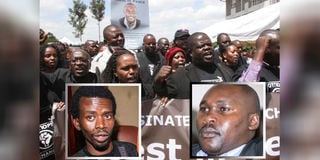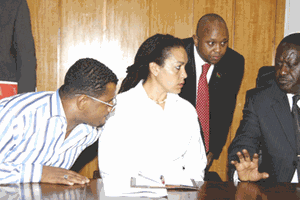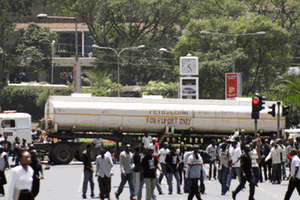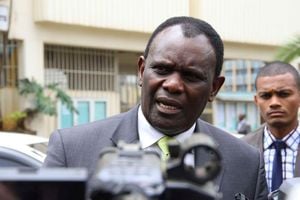
Members of the civil society sing during the burial of Oscar Kamau King’ara (inset: right) at his father’s home in Muchatha, Kiambaa, Kiambu County, on March 14, 2009. King’ara was shot dead alongside George Paul Oulu (inset: left) along State House Road on March 5, 2009.
March 5, 2009 was a tense Thursday in Nairobi. Security forces seemed overwhelmed by protesting members of the outlawed Mungiki sect who had paralysed activities in various parts of the city.
The protests were about the rise in extrajudicial killings by the police. The demonstrators had the backing of the Oscar Foundation, which had documented evidence of police excesses and also offered free legal aid to victims.
Earlier that afternoon, then Government Spokesperson Alfred Mutua, like police headquarters, had warned that stern action would be taken against any organisation abetting Mungiki activities.
At dusk, two officials of the Oscar Foundation, Oscar Kamau King’ara, 39, and George Paul (GP) Oulu, 26, were ambushed by gunmen in rush hour traffic along State House Road.
Oscar and his communications and advocacy officer were shot dead at point blank range at around 6.30pm.
The executions ignited another wave of protests by University of Nairobi (UoN) students. In the protracted chaos that stretched into the night, one of the students, Godwin Ogato, was shot by police. He was pronounced dead on arrival at the Kenyatta National Hospital.
Fifteen years later, we seek out key persons of interest regarding the executions that split the grand coalition government after President Mwai Kibaki and Prime Minister Raila Odinga’s factions took opposing positions on the killings that drew international condemnation.
Who were the hitmen who had trailed the two human rights activists and shot them dead? On whose behest were they acting? What was the motive for the Mafia-style murders? And why has the government failed to investigate, apprehend and prosecute those behind the killings?
Darkness was beginning to envelope the capital city as commuters rushed home from work. It was a usual routine they had become accustomed to, except this evening would be anything but ordinary. Almost on cue, a Mitsubishi Pajero drove out of the UoN gate next to male students’ hostel, Hall 11, onto State House Road.
The vehicle blocked a white Mercedes Benz registration number KAJ 179Z that was approaching. This wasn’t unusual as rogue motorists have the irritating habit of flouting traffic rules. Another car, a white caravan, according to witnesses, was behind the Mercedes Benz that Oscar and Oulu were in.
Apparently, the mystery occupants of the white caravan who were trailing the two had alerted the occupants of the Mitsubishi Pajero on the timing to cut off traffic. Then multiple gunshots rang out. Mission accomplished, the gunmen in the two vehicles sped away after igniting a storm whose aftershocks would be felt in Geneva.

Some of the oil tankers that were detained by protesting University of Nairobi students on Uhuru Highway/University Way roundabout March 10, 2009.
Mr David Osiany was a student leader at the time and participated in the protests following the shooting. He recalls how the gunmen who emerged from the white caravan approached the Mercedes Benz.
“They rained bullets on the occupants. It happened outside senior male students’ hostel, Hall 11. We came out only to find the person shot was GP Oulu, a former student leader at UoN whom we knew,” Mr Osiany, who was the representative of First Years at the Faculty of Arts, recounts the events of that fateful evening.
Mr Osiany, a former Chief Administrative Secretary, says when the students identified the former student leader among the victims, all hell broke loose.
“It became chaotic,” he recollects. “He had been on suspension for quite a while. It was attributed to his activism.”
A pedestrian had also been shot in the leg by a stray bullet.
For over three hours, the rioting students blocked police from taking the bodies from the scene. The enraged students had pushed the Mercedes Benz into the university compound.
Police finally stormed the campus at 10pm. That’s when Ogato was shot. He died on the way to hospital.
“Our last born brother who was also in the same university called me as I was preparing to go to work in the morning. He had tried calling me from midnight. He told me there was a problem,” Kitutu Masaba MP Clive Gisairo remembers how he got the news about the death of his elder brother Ogato.
At Vigilance House, police headquarters, police commissioner Hussein Ali, faced with a barrage of questions from a battery of journalists, only took responsibility for the killing of Ogato.
“A student was shot. That incident did not necessitate use of force at all. Accordingly, three officers are under arrest. They will be arraigned once investigations establish who fired that round that caused the fatality,” Maj-Gen (Rtd) Ali told journalists then.
Instead of Ogato’s killers being nailed, Mr Gisairo says, a grand cover-up unfolded.
“They did some twisting here and there. They tried to get the wrong officers with the wrong guns so that ballistic reports do not match. The person who shot him used a pistol, it was not a rifle. There’s no way a rifle will shoot in close range and the bullet remains in the body,” Mr Gisairo argues.
More protests followed to demand action against the killings. Initially the Internal Security ministry had declined to allow the demonstrations, but then Prime Minister Raila Odinga overruled the ministry. The police spokesman at the time, Eric Kiraithe, reached out to Ogato’s family to try calm the storm.

Prime Minister Raila Odinga (right) speaks to civil society organisations representatives in his office March 09, 2009. He directed Kenya police investigating the killing of two human rights activists to cooperate with officers from the United States in finding those responsible.
Also Read: Kenyan police accused of killing activists
“The police spokesman called me through a friend. We went to Sagret,” Mr Gisairo admits, referring to the hotel on Milimani Road.
“I had to inform him what we knew up to that point. I also gave him what lawful options were available. Generally, professionally, you don’t admit liability as police,” Mr Kiraithe discloses, seeking to explain the reason for the meeting.
Ogato, who was pursuing a Bachelor of Arts degree in economics, was buried in Kitutu Masaba. No State official or police officer was allowed near their home. But trouble for the State was only beginning over the killings of the Oscar Foundation officials.
Between 2007 and 2009, cases of lawlessness and extrajudicial killings had reached crisis levels in the country. Members of the proscribed Mungiki sect were carrying out brazen killings and running extortion rackets.
In August 2007, in an onslaught against the Mungiki, hundreds of police officers raided the Mathare shanty town and, when the guns fell silent, more than 30 people had been murdered in execution-style killings in the Nairobi slum. In April 2009, a month after the Oscar Foundation officials’ killings, Mungiki militia went on a murderous rampage in Mathira in Nyeri, killing at least 30 people to retaliate against the execution of their members by vigilante gangs in Kirinyaga.
Mungiki followers often staged protests in various towns every time bodies of gang members were discovered.
“Security wise, these were very sensitive days,” Mr Kiraithe recalls. “The country had just dealt with a turbulent phase of Mungiki menace in the CBD, which challenged police capacity.”
On the afternoon of the fateful day, the government spokesman had made sensational claims against officials of the Oscar Foundation. “We know that Mungiki has an NGO by the name of Oscar Foundation which they use to try and get funds from overseas,” Dr Mutua had claimed. “Action will be taken against any organisation abetting illegal activities.”
Hours later King’ara and his associate were dead. The killings occurred barely a week after UN special rapporteur on extrajudicial, summary or arbitrary executions, Phillip Alston, had released a report that indicted Kenyan authorities over extrajudicial killings.
High Court judge Sam Mohochi, who at the time served as executive director of the Independent Medico Legal Unit (Imlu), remembers that the assassinations shook the rights movement.
“This is one of my lowest moments as a human rights defender. We had never had such a direct attack on human rights activists,” Justice Mohochi says as he disputed claims Oscar received foreign financial support to aid Mungiki operations.
The Kenya National Commission on Human Rights was among civil society groups that protested Dr Mutua’s utterances.
“We cannot say for certain that Mutua said what happened but we are concerned that he said it then it happened. So we want an inquiry into that,” said Ms Florence Jaoko, then the KNCHR chairperson.
Mr Odinga condemned the executions as well as the utterances by the government spokesman.
“This act of heartless and lawlessness, murder most foul, came only hours after Dr Mutua in the name of the government accused the Oscar Foundation of fundraising abroad to support Mungiki activities locally. I wish to state to the people of Kenya that Dr Mutua does not speak for the grand coalition government,” Mr Odinga stated.
The police commissioner promised that those involved would be apprehended. But the PM accused the police of complicity in the murders and sought independent investigations by the United States Federal Bureau of Investigations (FBI).
“The government of the US has responded by offering two FBI officers to assist in investigations,” Mr Odinga declared.
Then US ambassador Michael Ranneberger said that FBI agents were ready to start investigations immediately.
However, then Internal Security minister George Saitoti said Kenyan police were capable of investigating the murders.
In June 2009, the warring factions of the Kenyan government took their divisions to the UN Security Council meeting in Geneva, Switzerland, where they had differing positions on Prof Alston’s report.
President Kibaki sent Prof Saitoti, Justice minister Mutula Kilonzo and Attorney-General Amos Wako to present the Kenyan position that poked holes into the report.
Mr Odinga dispatched a parallel delegation led by ministers James Orengo and Amason Kingi that supported Prof Alston’s findings.
“Kenya had an interest. It took the view that Alston had overstepped his mandate and had no business calling for the removal of AG Wako for instance. Raila’s ODM side supported Alston. It was becoming an international embarrassment,” Justice Mohochi observes.

University of Nairobi students demonstrate on the Uhuru Highway in Nairobi on March 10, 2009 following the shooting of one of their colleagues, John Paul Oulu, and his boss, Oscar King'ara.
In an interview last week, Prof Alston confirmed that the Oscar Foundation officials were among the many people he met at a Nairobi hotel in the course of his investigations. He acknowledged that they handed him what was considered as highly sensitive information.
“Sensitive not in the sense that it was secret information but sensitive in the sense that they accused police of involvement in large number of killings, the role of Mungiki and response by government to that role. They were asserting that a very large number of Mungiki had been executed,” Prof Alston discloses.
He goes on: “There were revelations about police-led (death) squads. Very traumatic…very detailed…and very convincing. The main conclusion which was supported by important testimony.”
In his report, which he made public at the United Nations Environmental Programme headquarters in Gigiri before leaving the country, he singled out a number of high ranking government officials.
“In my report, I noted that AG Wako had failed to prosecute most police officers who were involved. I also called for replacement of the police commissioner,” Prof Alston says.
Justice Mohochi explains that King’ara had been working in central Kenya and parts of Nairobi hence the organisation had gathered crucial information.
After the publication of Prof Alston’s report, threats to his life escalated, he discloses.
“Those threat levels were not just targeted at Kamau. They targeted many people. So when it occurred, we clearly knew this might have been a killing occasioned by individuals who have something to do with government,” Justice Mohochi says.
Mr Osiany adds there were reports that Oscar had compiled a list of Mungiki members who had carried out retaliatory attacks in Naivasha during the 2007/08 post-election violence.

Mr David Osiany, the then-chairman of the Students Organisation of Nairobi University during an interview at Nation Centre, Nairobi on February 10, 2010.
President Kibaki’s controversial re-election in December 2007 election had been contested by his main challenger, Mr Odinga, triggering post poll violence.
The violence started with attacks on perceived President Kibaki’s supporters in opposition strongholds mainly in Rift Valley and Nyanza, which was met with retaliatory attacks on perceived opponents in Naivasha.
After the two were forced to share power in a coalition government, subsequent International Criminal Court (ICC) trials targeted six prominent Kenyans that prosecutors designated as bearing the greatest responsibility for the violence.
ICC prosecutor Luis Moreno-Ocampo’s list of suspects included prominent politicians William Ruto, Uhuru Kenyatta and Henry Kosgey, as well as radio journalist Joshua arap Sang, then head of civil service Francis Muthaura and former police commissioner Hussein Ali.
All the cases have since collapsed largely because of intimidation of prosecution witnesses and withdrawal of testimony prosecution was accused of obtaining improperly.
“Rumours then claimed that Oscar had put down names of Mungiki members who may have been used in retaliatory attacks in Naivasha and were later hunted down by police and murdered. People posit that probably that’s the reason Oscar was executed,” Mr Osiany says.
Justice Mohochi notes: “I tend to think that the manner in which Mungikis had been dealt with…many were killed and Oscar was also from that community. One would think that he was working on a topic that was ruffling feathers within the Kikuyu leadership that was coincidentally again the leadership in power. So I could look at it that way. That’s how they ended up losing their lives.”
According to Prof Alston, the two slain men had strong views about those responsible for 2007/08 post-election violence.
“They were advocating for ICC. My main focus was alleged killing by police and Oscar Foundation was particularly concerned with what they saw as victimisation of people linked to Mungiki group and what they alleged was wide spread killing of those people by police,” he states.
“Elements involved in the killing must have been individuals with expertise and resources. They were most likely State agents, whether rogue or otherwise,” Justice Mohochi concludes.
On the killings coinciding with the release of his damning report, Prof Aliston observes: “I said within the day of their execution that all of the evidence that was available then pointed to the high likelihood that the executions were at the instigation of the police. There were so many different circumstantial evidentiary facts that pointed in that direction and the fact that police never found or did anything and the only response from officials are basically character assassination of Oscar and GP.”
After the twin murders, controversy over the ownership of Oscar’s white Mercedes Benz registration KAJ 179Z emerged. Police alleged the vehicle had been stolen but this claim has been discredited as an attempt to distract from the killings.
“They were statements that emanated from police. Instead of investigating the killings, they were investigating the vehicle he was driving and claimed stories nobody had even heard of before. Oscar had been driving that vehicle for five years. I knew him. We don’t know who came up to claim ownership,” says Justice Mohochi.
Pressed about the stolen vehicle claim, Kiraithe responds he wasn’t aware how that issue ended.
“I don’t know whether that case was concluded. You’ll feel I am elusive but it’s very unwise to discuss an exhibit, whether past or present, unless of course the case has been concluded. We gave information we felt the public needed to know so that they don’t look at a case from one angle. Maybe if you get in touch with flying squad successors. Who told you it never went to court?” Kiraithe poses.
IMLU, which offered expertise in terms of forensic documentation, provided a pathologist for the victims’ families, hoping to push for a public inquiry.
But the families still reeling from the shock declined to take that route for unknown reasons.
IMLU this week shared the post mortem examination reports of the two victims conducted by Dr Andrew Gachii at Montezuma funeral home.
A summary of anatomical injuries on Oscar’s body noted the following;
A gunshot entry wound on the right side of face and exiting on the left eyebrow. The bullet penetrated the maxillary bone and exited on the left side of the face.
Another gunshot entry on the right side of face exiting at the left lower jaw joint area. The bullet fractured frontal skull bone and exited on the lateral edges of the left eyebrow.
A third gunshot entry wound on the right extensively fracturing the base of skull and exiting on the upper part of the neck.
The cause of death was determined as injuries to the skull and the brain due to multiple gunshot wounds to the head.
The pathologist commented that the projectile was likely to have been fired from high velocity rifled weapon at distance of over one meter.
On examining Oulu’s body, the pathologist found one gunshot wound to the right side of the chest - penetrating the right lung, heart diaphragm and left lobe of liver, associated massive chest and abdominal bleeding.
It was a single gunshot entry that penetrated the chest cavity, perforating the upper lobe of the right lung and then the right ventricle of the heart. The bullet was found lodged in the stomach.
There were gunshot wounds to the right upper arm and the left hand. The cause of death was massive bleeding.
Dr Gachii commented that the bullet was likely to have been fired by a rifled weapon at a distant.
The retrieved bullets were submitted for ballistic studies.
From the post mortem report, it was apparent given the number of times he had been shot and the extent of the injuries, Oscar was the main target. Oulu might have been collateral, a man at the wrong place at the wrong time.
Another observation about the Mafia-style executions was the scene of crime.
“How could such killings be done on State House road, the most secure which leads to the seat of power?” Osiany wonders.
“Extrajudicial killings, especially ones committed by rogue cops, have a terminology they use; they call it Hollywood. They create a scene,” Justice Mohochi remarks.
The murder case has been cold for 15 years. Our efforts to secure an interview with Dr Mutua, who is now serving in cabinet, were futile. The Cabinet Secretary declined to answer our calls or respond to text messages sent to his personal mobile phone contact despite reading them, as well as his office contacts. He also did not respond to email inquiries. Wako also did not respond to our inquiries.
“When former government spokesperson gave a warning directed to Oscar then a couple of hours they were shot dead, he owes the country two things, his truth and the truth,” Osiany says.
Kiraithe remarks: I wouldn’t want to guess whether criminal elements took advantage of his comments.”
“There was also a statement by Kiraithe, a prime defender of the police force. Evidence seems to be absolutely overwhelming in pointing to the direct involvement of the police,” Prof Alston concludes.
“I know the police commissioner even directed CID headquarters to take interest in the matter,” Kiraithe counters.
Investigations into the triple murders of Oscar, Oulu and Ogato got nowhere. An inquest wasn’t set up either despite the public interest the killings generated.
Justice Mohochi argues the solution to all cold murder cases lies in the operationalisation of the National Coroner’s Service Act.
“The coroner will also be performing the public inquest- scientifically investigating deaths but also performing quasi-judicial function. If that Act is operationalised, then provisions of section 386/7 of criminal procedure code would cease from being operational, then you’ll have an outfit that 24/7 does inquest across the country,” the judge says.
But since criminal cases have no statutory timelines, in the event an investigation was to be started, who are possible persons of interest and where would such a probe begin?
“They would start with individuals who had been recorded as having issued threats,” Justice Mohochi suggests.
“For the murder itself, the individuals who did the shooting and any parties that facilitated the individuals. If government doesn’t investigate the killings, then it’s implicating itself,” Prof Alston concludes.










